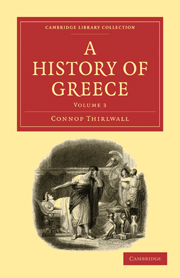Book contents
- Frontmatter
- Contents
- CHAPTER XVII FROM THE COMMENCEMENT OF THE ATHENIAN MARITIME ASCENDANCY TO THE THIRTY YEARS' TRUCE BETWEEN ATHENS AND SPARTA
- CHAP. XVIII FROM THE COMMENCEMENT OF THE THIRTY YEARS' TRUCE TO THE RENEWAL OF HOSTILITIES BETWEEN ATHENS AND CORINTH, WITH A GENERAL VIEW OF THE ADMINISTRATION OF PERICLES
- CHAP. XIX CAUSES AND OCCASIONS OF THE PELOPONNESIAN WAR
- CHAP. XX FROM THE COMMENCEMENT OF THE PELOPONNESIAN WAR TO THE END OF THE THIRD YEAR
- CHAP. XXI FOURTH AND FIFTH YEARS OF THE PELOPONNESIAN WAR
- CHAP. XXII FROM THE BEGINNING OF THE SIXTH YEAR OF THE PELOPONNESIAN WAR TO THE GENERAL PACIFICATION OF SICILY
- CHAP. XXIII FROM THE GENERAL PACIFICATION OF SICILY TO THE PEACE OF NICIAS
- CHAP. XXIV FROM THE PEACE OF NICIAS TO THE CONQUEST OF MELOS
- CHAP. XXV THE SICILIAN EXPEDITION BEFORE THE ARRIVAL OF GYLIPPUS IN SICILY
- CHAP. XXVI THE SICILIAN EXPEDITION FROM THE ARRIVAL OF GYLIPPUS TO ITS CLOSE
- APPENDIX
CHAP. XXVI - THE SICILIAN EXPEDITION FROM THE ARRIVAL OF GYLIPPUS TO ITS CLOSE
Published online by Cambridge University Press: 05 July 2011
- Frontmatter
- Contents
- CHAPTER XVII FROM THE COMMENCEMENT OF THE ATHENIAN MARITIME ASCENDANCY TO THE THIRTY YEARS' TRUCE BETWEEN ATHENS AND SPARTA
- CHAP. XVIII FROM THE COMMENCEMENT OF THE THIRTY YEARS' TRUCE TO THE RENEWAL OF HOSTILITIES BETWEEN ATHENS AND CORINTH, WITH A GENERAL VIEW OF THE ADMINISTRATION OF PERICLES
- CHAP. XIX CAUSES AND OCCASIONS OF THE PELOPONNESIAN WAR
- CHAP. XX FROM THE COMMENCEMENT OF THE PELOPONNESIAN WAR TO THE END OF THE THIRD YEAR
- CHAP. XXI FOURTH AND FIFTH YEARS OF THE PELOPONNESIAN WAR
- CHAP. XXII FROM THE BEGINNING OF THE SIXTH YEAR OF THE PELOPONNESIAN WAR TO THE GENERAL PACIFICATION OF SICILY
- CHAP. XXIII FROM THE GENERAL PACIFICATION OF SICILY TO THE PEACE OF NICIAS
- CHAP. XXIV FROM THE PEACE OF NICIAS TO THE CONQUEST OF MELOS
- CHAP. XXV THE SICILIAN EXPEDITION BEFORE THE ARRIVAL OF GYLIPPUS IN SICILY
- CHAP. XXVI THE SICILIAN EXPEDITION FROM THE ARRIVAL OF GYLIPPUS TO ITS CLOSE
- APPENDIX
Summary
Gylippus had been joined at Asine, where he had manned two Laconian galleys, by two others from Corinth, under the command of Pythen. With these they sailed to Leucas, where they were led by a concurrence of many false rumours to believe that Syracuse was already completely invested; and Gylippus, considering the affairs of Sicily desperate, only hoped that he might be in time to counteract the influence of the Athenians among the Italian Greeks. While therefore the Corinthians were fitting out a squadron, consisting of ten of their own galleys, two Leucadians, and three from Ambracia, he and Pythen pushed across to Tarentum, and proceeded to Thurii, where, through his father Cleandridas, who in his exile had been admitted a citizen there, he had connections which he hoped might enable him to arm the Thurians against Athens. But his small force, which seemed only fit for a piratical adventure, did not encourage them to comply with his wishes, and he continued his voyage westward. But before he reached Locri he was driven out to sea by a gale from the north, and with some difficulty made Tarentum again, where he was forced to wait for a time to refit. Intelligence of his approach had gone before him to the Athenian camp; and Nicias might easily have provided means for stopping or intercepting his little squadron. The military virtue which Nicias possessed in the highest degree was prudence; the failing toward which he most leaned, timidity.
- Type
- Chapter
- Information
- A History of Greece , pp. 414 - 458Publisher: Cambridge University PressPrint publication year: 2010First published in: 1836



